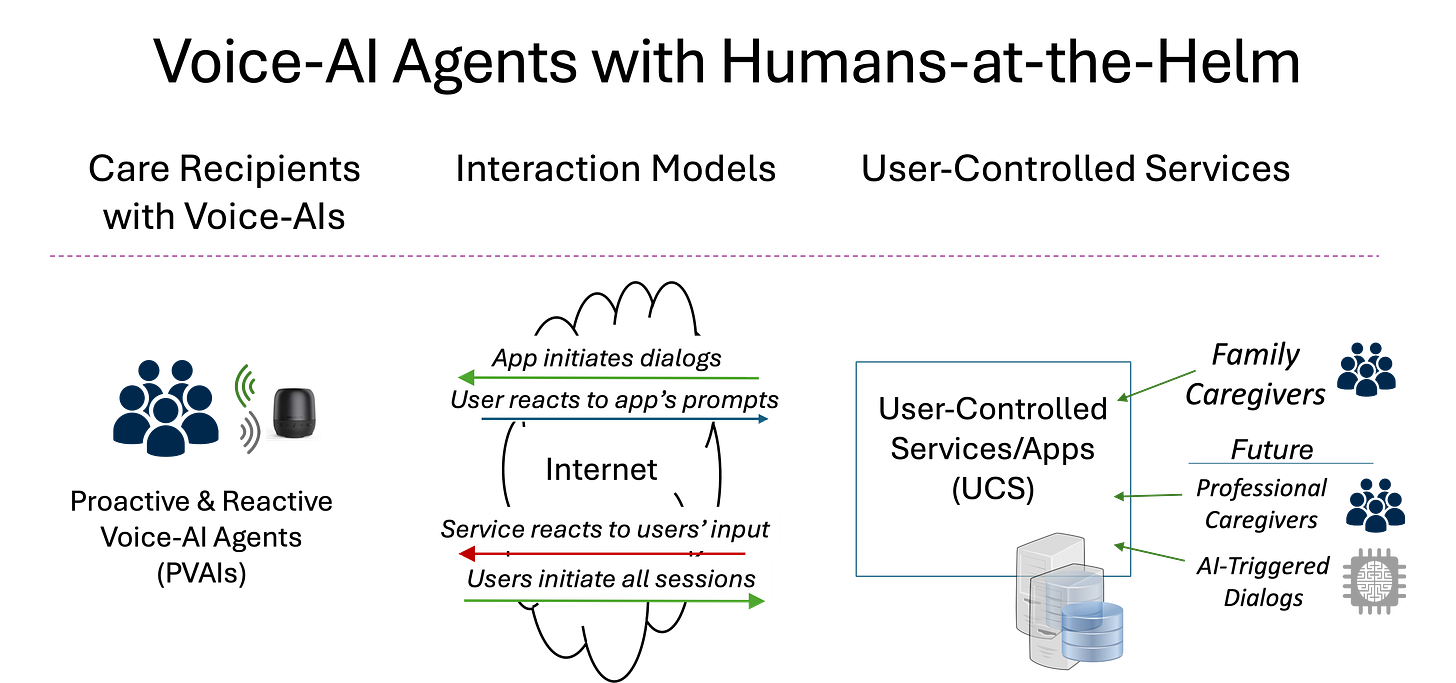Who controls digital care for your parent? (Hint: It should be you)
Introductory Series • Post 4
In our last post, we introduced two innovations—PVAIs and UCS—that finally make the web work for family caregivers. Today, we’ll explore how these innovations serve both sides of the caregiving relationship and reveal who else can join the circle of care.
Yesterday, we described a new model for e-care that extends the legacy, self-service web to support configurable voice-AI agents. Here’s the graphic:
Quick recap:
This model introduces two key innovations: Proactive Voice-AI Agents (PVAIs) that initiate conversations with care recipients on behalf of their caregivers throughout the day, and User-Controlled Services (UCS) that let caregivers provide the agency and intelligence to configure those dialogs for both their needs and their loved one’s needs.
Together, these innovations will transform today’s reactive-only, host-controlled model into a new one—where caregivers are “at-the-helm.”
The power of proactive, user-controlled VAIs
As we described in Post 2, today’s mobile apps and services are all designed and controlled by a service or app owner. While we can choose when and how to visit a website or open a mobile app, every other user experiences the same interface and, almost always, the same content.
This new e-care architecture changes everything.
It enables a caregiver to configure a friendly voice-AI agent
to proactively deliver a service tailored to their care recipient’s unique needs.
An ambient, proactive VAI means the care recipient no longer needs to know how to use a smartphone, check texts, or even “wake up” a VAI with a command.
A proactive VAI—configured by someone else—will be the first truly effortless UI for the millions of users with disabilities who currently cannot access or benefit from the online services that able-bodied users take for granted. No typing or tapping, no struggling to read a small screen or remember commands—just natural conversations initiated by a VAI that’s been configured by their caregiver.
It’s as if someone were in the room with them—speaking with the agency of their caregiver—talking naturally throughout the day.
For care recipients, it finally tears down the persistent barriers of the “digital divide.”
For family caregivers, a proactive VAI is the first digital connection they can truly trust … because they control it.
Combined with smart-home sensors and apps, it will give caregivers 24/7 agency and peace of mind when they can’t be there in person or can’t afford to pay someone else to be there instead!
Giving users control of their online world
The idea of users having some control over their online experience isn’t entirely new. It began with user-generated content (UGC).
UGC allows users to upload content they’ve created—images, videos, audio, text—and interact with others based on that content. It spawned some of the most popular, profitable apps billions of us use daily: Facebook, LinkedIn, Airbnb, YouTube, and countless dating apps.
The UCS model goes much further than UGC. It enables a user to control not just the content another user sees or hears, but to define the app or service itself—what a PVAI talks about and when—and to control the invaluable data it generates and collects.
UCS will enable family caregivers to configure a PVAI to serve both as their proactive “voice” and as the voice of other care-providing services—human or automated—such as:
A physician or service informing their aging parent of test results,
A smart-home device announcing that someone’s at the door, and
A motion detector proactively checking if an older relative is “okay” because they haven’t gotten out of bed yet.
In future posts, we’ll explore each of these potential additions to the PVAI+UCS solution—professional caregivers, smart-home devices/apps, and passive in-home sensors—in detail.
You’ll see that PVAIs can and should augment all of these point solutions, but only if and when the family caregiver remains at-the-helm!
We hope you’ll subscribe and join us on this journey...

